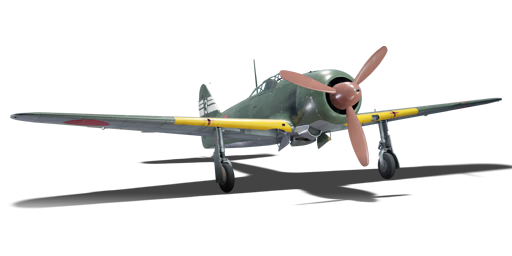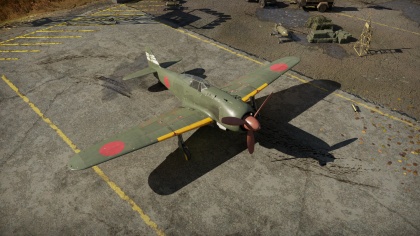Difference between revisions of "Ki-100-II"
m (→Details) |
(→Pros and cons) |
||
| Line 231: | Line 231: | ||
'''Pros:''' | '''Pros:''' | ||
| − | * Generous ammo load | + | * Nose-mounted Ho-5 cannons gives you better chance in head-ons |
| − | * | + | * Generous ammo load |
| − | + | * Good climb rate and decent turn time | |
* Doesn't lock up too badly at high speed | * Doesn't lock up too badly at high speed | ||
* Flexible fighting style | * Flexible fighting style | ||
| + | * Turbocharger improves high altitude performance | ||
'''Cons:''' | '''Cons:''' | ||
| + | * Ho-5 cannons are low velocity | ||
* Average roll rate | * Average roll rate | ||
* Fragile, vulnerable to fires | * Fragile, vulnerable to fires | ||
| − | |||
* No considerable strengths in performance | * No considerable strengths in performance | ||
Revision as of 20:48, 26 August 2020
Contents
| This page is about the the aircraft Ki-100-II. For other uses, see Ki-61 (Family). |
Description
The Ki-100-II is a Rank III premium Japanese fighter
with a battle rating of 5.0 (AB) and 3.7 (RB/SB). This aircraft was introduced in Update 1.65 "Way of the Samurai".
General info
Flight Performance
| Characteristics | |||||||
|---|---|---|---|---|---|---|---|
| Stock | |||||||
| Max Speed (km/h at 10,000 m) |
Max altitude (metres) |
Turn time (seconds) |
Rate of climb (meters/second) |
Take-off run (meters) | |||
| AB | RB | AB | RB | AB | RB | ||
| 567 | 550 | 12000 | 22.0 | 22.7 | 10.1 | 10.1 | 420 |
| Upgraded | |||||||
| Max Speed (km/h at 10,000 m) |
Max altitude (meters) | Turn time (seconds) | Rate of climb (meters/second) |
Take-off run (meters) | |||
| AB | RB | AB | RB | AB | RB | ||
| 616 | 590 | 12000 | 20.5 | 21.0 | 18.1 | 13.5 | 420 |
Details
| Features | ||||
|---|---|---|---|---|
| Combat flap | Take-off flap | Landing flap | Air brakes | Arrestor gear |
| ✓ | ✓ | ✓ | X | X |
| Limits | ||||
|---|---|---|---|---|
| Wing-break speed (km/h) |
Gear limit (km/h) |
Combat flap (km/h) |
Max Static G | |
| + | - | |||
| 0 | 250 | ??? | ~?? | ~? |
| Optimal velocities | |||
|---|---|---|---|
| Ailerons (km/h) |
Rudder (km/h) |
Elevators (km/h) |
Radiator (km/h) |
| < ??? | < ??? | < ??? | > ??? |
| Compressor (RB/SB) | ||
|---|---|---|
| Setting 1 | ||
| Optimal altitude | 100% Engine power | WEP Engine power |
| ?,??? m | ??? hp | ?,??? hp |
Survivability and armour
- 13 mm steel plate behind the pilot seat and headrest
Armaments
Offensive armament
The Ki-100-II is armed with:
- 2 x 20 mm Ho-5 army cannons, nose-mounted (250 rpg = 500 total)
- 2 x 12.7 mm Ho-103 army machine guns, wing-mounted (250 rpg = 500 total)
Suspended armament
The Ki-100-II can be outfitted with the following ordnance:
- Without load
- 2 x 50 kg Army Type 94 GPHE bombs (100 kg total)
- 2 x 100 kg Army Type 94 GPHE bombs (200 kg total)
- 2 x 250 kg Army Type 92 GPHE bombs (500 kg total)
Usage in battles
Pilots of the standard Ki-100 found in the tech tree should feel relatively comfortable in the premium Ki-100-II. This aircraft offers balanced performance characteristics that allow the pilot to choose how he wishes to fight in the Ki-100-II and adapt to the combat situation as necessary. The performance of the Ki-100-II is characterized by decent climb rate and maneuverability. The aircraft has good (but not the best) acceleration in a dive that makes it suitable for short range "boom and zoom" style attacks. The pilot should position the fighter around 1000 meters above a selected target, dive rapidly, fire a quick burst, and then pull away in a shallow climb to hold the plane's speed and escape. This is the safest way to conduct combat in the Ki-100-II, but there are other options available.
Against less manoeuvrable opponents, turn fighting can be a valid approach. Most German and American aircraft will not be able to out-turn you. However, turning combat is only advised when there are no other enemies around that could pounce on you while you are focused on your target. Do not manoeuvre for too long and avoid getting too slow, because your control surfaces will become less responsive. Then you will be a sitting duck for most other fighters.
With sufficient speed, the Ki-100-II also has suitable energy retention characteristics for spiral climbs and other moves that can drain your opponent's energy. However, there are other fighters which are still superior in this regard.
Manual Engine Control
| MEC elements | ||||||
|---|---|---|---|---|---|---|
| Mixer | Pitch | Radiator | Supercharger | Turbocharger | ||
| Oil | Water | Type | ||||
| Controllable | Not controllable | Not controllable | Not controllable | Separate | Not controllable | Not controllable |
Modules
| Tier | Flight performance | Survivability | Weaponry | |||
|---|---|---|---|---|---|---|
| I | Fuselage repair | Radiator | Offensive 12 mm | 7 in (mod20) | ||
| II | Compressor | Airframe | Offensive 20 mm | 10 in (mod24) | ||
| III | Wings repair | Engine | New 12 mm MGs | 12 in (mod30) | ||
| IV | Engine injection | Cover | New 20 mm cannons | |||
| This is a premium vehicle: all modifications are unlocked on purchase | ||||||
Pros and cons
Pros:
- Nose-mounted Ho-5 cannons gives you better chance in head-ons
- Generous ammo load
- Good climb rate and decent turn time
- Doesn't lock up too badly at high speed
- Flexible fighting style
- Turbocharger improves high altitude performance
Cons:
- Ho-5 cannons are low velocity
- Average roll rate
- Fragile, vulnerable to fires
- No considerable strengths in performance
History
The Ki-100-II was a prototype version of the Ki-100, built to improve its high altitude performance in order to improve interception capabilities against high flying American B-29s. It replaced the Ki-100's regular engine with a turbocharged, water-methanol injected one that enhanced performance above 8 kilometres. Ultimately, only 3 were built, with none of them ever seeing combat.
Media
Excellent additions to the article would be video guides, screenshots from the game, and photos.
See also
Links to the articles on the War Thunder Wiki that you think will be useful for the reader, for example:
- reference to the series of the aircraft;
- links to approximate analogues of other nations and research trees.
External links
Paste links to sources and external resources, such as:
- topic on the official game forum;
- encyclopedia page on the aircraft;
- other literature.
| Kawasaki Aircraft Industries (川崎航空機工業株式会社) | |
|---|---|
| Biplane Fighters | Ki-10-I · Ki-10-I C · Ki-10-II · Ki-10-II C |
| Fighters | Ki-61-I ko · Ki-61-I otsu · Ki-61-I hei · Tada's Ki-61-I hei · Ki-61-I tei · Ki-61-II Otsu Kai |
| Ki-100 · Ki-100-II | |
| Interceptors | Ki-45 ko · Ki-45 otsu · Ki-45 hei · Ki-45 tei |
| Ki-96 | |
| Ki-102 otsu | |
| Ki-108 Kai | |
| Bombers | Ki-32 |
| Ki-48-II otsu | |
| Captured | ␗Ki-45 hei/tei · ␗Ki-61-I otsu · ▃Ki-61-Ib |
| See also | Kawasaki Shipyard Co. |
| Japan fighters | |
|---|---|
| Navy | |
| Carrier-based fighter | |
| A5M | A5M4 · Hagiri's A5M4 |
| A6M | A6M2 mod. 11 · A6M2 · A6M3 · A6M3 mod. 22 · A6M3 mod. 22Ko · A6M5 · A6M5 Ko · A6M5 otsu · A6M5 Hei · A6M6c |
| A7He | A7He1* |
| A7M | A7M1 (NK9H) · A7M2 |
| Land-based Fighter | |
| J2M | J2M2 · J2M3 · J2M4 Kai · J2M5 · J2M5 (30 mm) |
| J6K | J6K1 |
| J7W | J7W1 |
| N1K-J | N1K1-Ja · N1K2-J · N1K2-Ja |
| Fighter seaplane | |
| N1K | N1K1 |
| A6M-N | A6M2-N |
| Army | |
| Ki-10 | Ki-10-I · Ki-10-I C · Ki-10-II · Ki-10-II C |
| Ki-27 | Ki-27 otsu · Ki-27 otsu Tachiarai |
| Ki-43 | Ki-43-I · Ki-43-II · Ki-43-III otsu |
| Ki-44 | Ki-44-I · Ki-44-I 34 · Ki-44-II otsu · Ki-44-II hei |
| Ki-61 | Ki-61-I ko · Ki-61-I otsu · Ki-61-I hei · Tada's Ki-61-I hei · Ki-61-I tei · Ki-61-II Otsu Kai |
| Ki-84 | Ki-84 ko · Ki-84 otsu · Ki-84 hei |
| Ki-87 | Ki-87 |
| Ki-94 | Ki-94-II |
| Ki-100 | Ki-100 · Ki-100-II |
| Other countries | ▅F4U-1A · ▅P-51C-11-NT · ▅Bf 109 E-7 · ▅Fw 190 A-5 |
| *Imported designation of the He 112 (A6M was in development - A7M would take A7 designation after the cancelation of the A7He) | |
| Japan premium aircraft | |
|---|---|
| Fighters | Hagiri's A5M4 · A7He1 · Ki-27 otsu Tachiarai |
| Ki-44-II otsu · ▅Bf 109 E-7 · ▅F4U-1A · Ki-100-II · Ki-44-I 34 | |
| ▅Fw 190 A-5 · A7M1 (NK9H) · Tada's Ki-61-I hei · ▅P-51C-11-NT | |
| J2M4 Kai · A6M5 Ko · A6M6c · J2M5 · Ki-87 · J6K1 | |
| Twin-engine fighters | Ki-96 |
| Jet fighters | F-86F-40 JASDF▅ · T-2 Early · F-4EJ ADTW |
| Strike aircraft | ▄AV-8S |
| Bombers | Ki-21-I hei · Ki-48-II otsu · H8K3 · B7A2 (Homare 23) · ▅B-17E |





